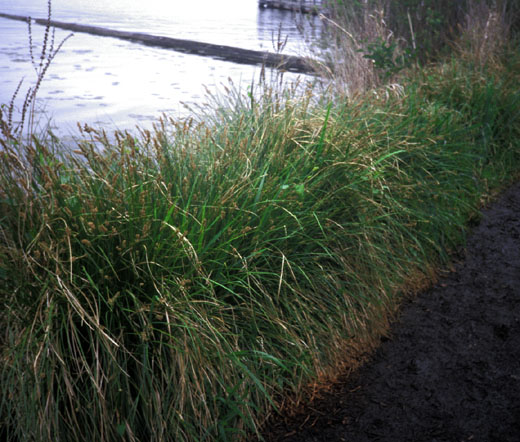
|
Sedges
|
| Grasses, rushes and sedges are three big plant categories closely
related to one another. Each essentially constitutes its own plant family.
Sedges are remarkable for being extremely numerous as to species,
widely distributed, yet practically unknown by name to most people. The
sedge genus is called in science Carex--the Latin name. No other species
of plants wild in the Pacific Northwest comes close to
Carex for number of kinds. There are some 133 different species here! Did God love them
or what? In the San Juan Islands 32 grow; in the Olympic Peninsula 64
grow. Seattle and its nearby environs (such as the Eastside) have at least 20
kinds reported wild, one of which is dramatic Old World species which
has escaped from cultivation: Carex pendula, the drooping sedge. |
| Fanciers of ornamental grasses grow various non-native sedge
species, several of which are antipodean, bronze or brown colored and look
dead. In Seattle gardens these often reseed, but I don't consider any
naturalized here --yet. The most likely species to do so may be the New
Zealander Carex Buchananii. Curious, no New Zealand plants of any kind are
yet naturalized in Seattle, although we do have some from South
America and South Africa. Well, we're a world class city, right? Make room, locals. |
| I've spent time this year learning to recognize all of Seattle's
wild sedges. This is not the work of a moment, nor is it easy. So far I only
know 12 of the 20. Microscopic examination of the sedge's reproductive
parts is necessary, in conjunction with careful consulting of a heartless,
very technical scientific manual of more than 900 pages and over 5 pounds
(the weight of a standard brick). Why bother? It pleases me to be on a
first-name basis with Seattle's wild plants. The nearest parallel which leaps
to mind is to be able to call different dog breeds by their specific names
(e.g., greyhound, poddle, collie, St. Bernard). Imagine if all you knew was
the general "dog" title. To reel off species of
Carex is, then, sort of a botanical equivalent of a mountaineer's assault of Mt. Everest. The tasks
are different primarily in that few care to even try
Carex identification, and neither risk nor glamor attends those who do so. |
When I am very well acquainted with Seattle's sedges I'll make
the results of my study available, in plain English, with emphasis on the
most fascinating aspects of each species. This one will have the best
flower display, that one will be notable for ornamental foliage; this other
only grows in saltwater sand dunes; and that plain-looking one tastes good
if you know what you're doing. All will be illustrated, along with details
as to where exactly they grow. It will be easier, then, for others to
get acquainted with a genus that obviously has something going for it,
to account for its great size --1,000 to 1,500 or more species globally.
|
(originally published in The Seattle Weekly, July 1997)
Back |
|
|

